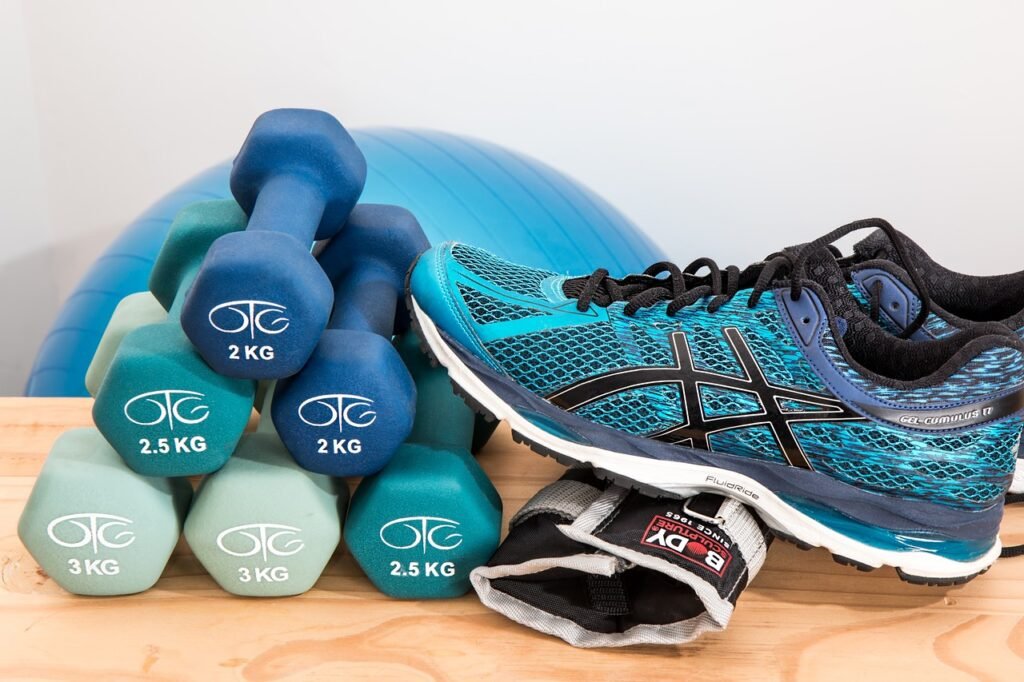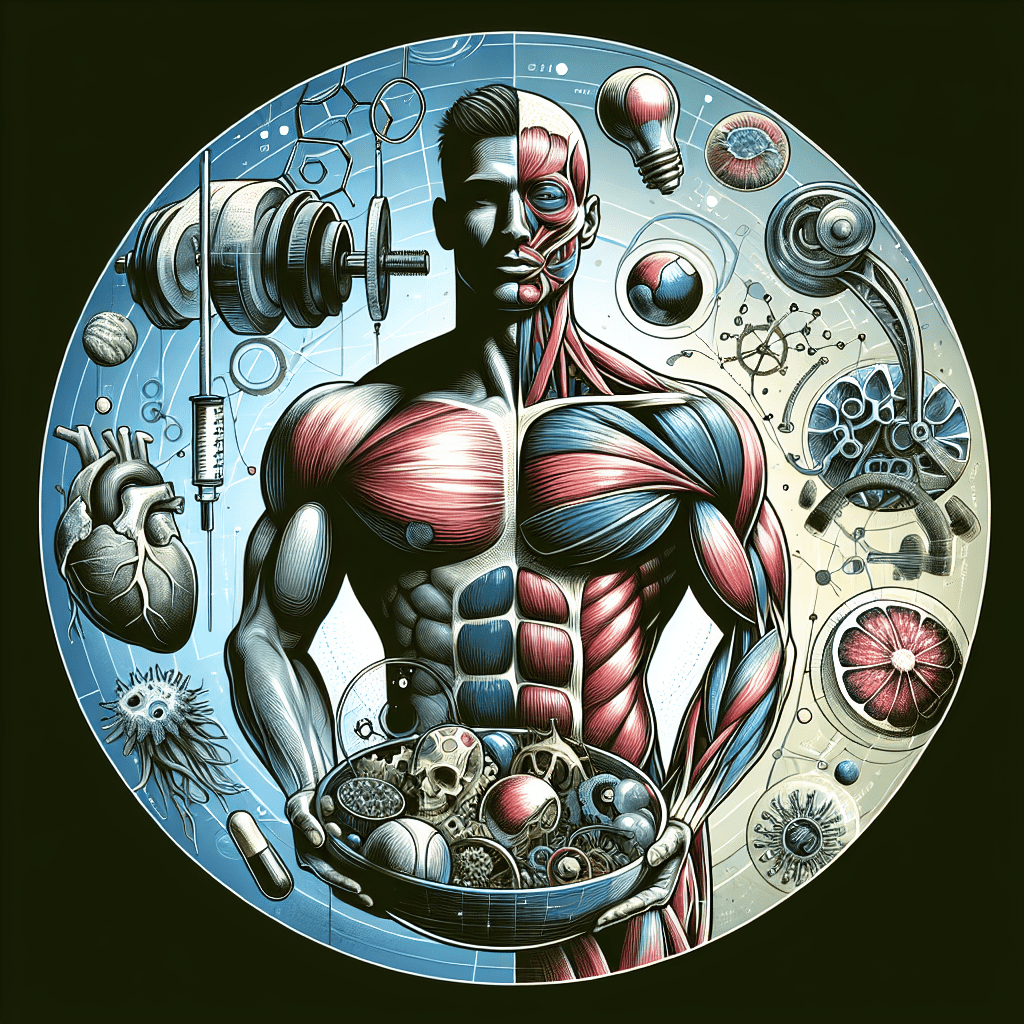Get ready to discover the fascinating world of building lean muscle mass! In this article, you will delve into the science behind this process, uncovering the secrets behind achieving a toned and strong physique. From understanding the role of protein synthesis to the importance of progressive overload, we will break down the key factors that contribute to building lean muscle. So, get your workout gear on and prepare to transform your understanding of muscle growth.
Table of Contents
ToggleWhat is Lean Muscle Mass?
Lean muscle mass refers to the amount of muscle tissue in your body that is not accompanied by excess body fat. It is the culmination of various factors such as muscle fiber types, genetics, hormonal influences, dietary factors, resistance training, muscle hypertrophy, recovery, progressive overload, and the use of supplements. Building lean muscle mass not only enhances your physical appearance but also provides numerous health benefits, including improved metabolism, increased strength and endurance, better body composition, and reduced risk of injuries.
Definition
Lean muscle mass is characterized by a higher proportion of muscle tissue and a lower amount of body fat. It is achieved through a combination of strength training exercises and a balanced diet. Unlike bulky muscle mass, lean muscle mass allows for a more defined and sculpted physique, as it focuses on building strong, toned muscles without excess fat.
Benefits
There are several benefits to building and maintaining lean muscle mass. Firstly, lean muscle helps to increase your metabolic rate, which means that your body burns more calories even at rest. This can be advantageous for those looking to lose weight or maintain a healthy body weight. Secondly, building lean muscle improves overall strength and endurance, making everyday tasks easier and reducing the risk of injuries. Thirdly, lean muscle mass contributes to a better body composition, as it helps to create a proportionate and aesthetically pleasing physique. Additionally, having lean muscle mass has been linked to improved bone density, enhanced insulin sensitivity, and better overall health and longevity.
Understanding Muscle Fiber Types
When it comes to building lean muscle mass, it is crucial to understand the different types of muscle fibers in the body. Two primary types of muscle fibers play a role in muscle growth and performance: slow-twitch fibers and fast-twitch fibers.
Slow-Twitch Fibers
Slow-twitch muscle fibers, also known as type I fibers, are responsible for endurance activities that require sustained contractions over an extended period. These fibers are rich in mitochondria, which provide energy for long-duration activities such as marathon running or cycling. Slow-twitch fibers have a smaller cross-sectional area compared to fast-twitch fibers, making them less prone to hypertrophy. However, they are resistant to fatigue and play a vital role in maintaining posture and stability.
Fast-Twitch Fibers
Fast-twitch muscle fibers, also referred to as type II fibers, are responsible for explosive and powerful movements such as weightlifting or sprinting. These fibers can be further classified into type IIa and type IIb fibers. Type IIa fibers have a combination of characteristics from both slow-twitch and fast-twitch fibers, allowing for a balance of endurance and strength. Type IIb fibers, on the other hand, are larger and generate more force but fatigue quickly. Fast-twitch fibers are capable of significant hypertrophy in response to resistance training.
Understanding your dominant fiber type can help tailor your training program to optimize muscle growth and performance. While genetics play a role in determining fiber composition, it is possible to improve the characteristics of both slow-twitch and fast-twitch fibers through appropriate training methods.
The Role of Genetics in Muscle Building
Genetics plays a significant role in determining an individual’s muscle-building potential. Muscle fiber composition, which is largely genetically determined, affects an individual’s response to resistance training and their ability to build lean muscle mass.
Inheritance of Muscle Fiber Composition
Muscle fiber composition is primarily determined by genetic factors. Research has identified specific genes associated with muscle fiber types, such as the ACTN3 gene, which influences fast-twitch muscle fibers. Individuals may inherit a higher proportion of either slow-twitch or fast-twitch fibers from their parents, which can impact their ability to excel in certain activities or sports.
While genetics do influence muscle fiber composition, it is important to note that they do not solely determine an individual’s potential for muscle growth. Through proper training techniques and the right lifestyle choices, individuals can optimize their muscle-building capabilities regardless of their genetic predisposition.
Genetic Variability
It is worth noting that there is significant variability in muscle fiber composition among individuals. Even within the same family, members may have different proportions of slow-twitch and fast-twitch fibers. This genetic variability means that each person may respond differently to training stimuli. Some individuals may naturally possess a greater capacity for muscle hypertrophy and strength gains, while others may have to work harder to achieve similar results. However, with consistent effort and appropriate training methods, individuals can make significant progress regardless of their genetic factors.
Hormonal Influence on Muscle Growth
Hormones play a vital role in muscle growth and development. Certain hormones, such as testosterone, growth hormone, and insulin-like growth factors, have a direct impact on muscle protein synthesis and hypertrophy.
Testosterone
Testosterone is the primary male hormone that plays a crucial role in muscle growth. It stimulates protein synthesis, increases muscle mass, and enhances strength and power. Testosterone levels naturally vary between individuals and are influenced by factors such as age, sex, and genetics. Higher testosterone levels tend to be associated with greater muscle-building potential. However, it is worth mentioning that females also produce testosterone, although in smaller amounts. Adequate resistance training coupled with a balanced lifestyle can help optimize testosterone levels for muscle growth.
Growth Hormone
Growth hormone (GH) is another hormone that contributes to muscle growth and repair. It stimulates the release of insulin-like growth factors (IGFs) from the liver, promoting muscle protein synthesis. GH is secreted in pulses throughout the day, with the highest concentrations occurring during deep sleep. Adequate sleep and recovery are essential for maximizing GH release and its anabolic effects on muscle tissue.
Insulin-Like Growth Factors
Insulin-like growth factors (IGFs) are an important family of proteins that stimulate muscle growth and development. IGF-1, in particular, is known for its anabolic properties, promoting muscle hypertrophy and enhancing muscle satellite cell activation. IGF levels are influenced by factors such as exercise, nutrition, and sleep. Resistance training and adequate protein intake are key factors in optimizing IGF production for muscle growth.
Understanding the roles of these hormones and their interactions can help individuals tailor their training, nutrition, and lifestyle choices to optimize muscle growth.
Dietary Factors for Building Lean Muscle Mass
Proper nutrition is crucial for building lean muscle mass. Certain dietary factors, including protein intake, carbohydrates, fats, and micronutrients, play a significant role in muscle growth and repair.
Protein Intake
Protein is the building block of muscle tissue and is essential for muscle protein synthesis. It provides the necessary amino acids that are required for repairing and rebuilding muscle fibers after exercise-induced damage. Adequate protein intake is crucial for optimizing muscle growth. The general recommendation for individuals engaged in strength training is to consume 1.2 to 2 grams of protein per kilogram of body weight per day. High-quality protein sources such as lean meats, poultry, fish, eggs, dairy products, and plant-based proteins like beans and legumes should be incorporated into the diet to support muscle growth.
Carbohydrates and Fats
Carbohydrates and fats are also vital macronutrients for muscle growth and energy production. Carbohydrates serve as the primary fuel source during intense exercise, providing the energy required for muscle contraction. Adequate carbohydrate intake ensures optimal performance and supports the anabolic processes necessary for muscle growth. Similarly, healthy fats such as avocados, nuts, and seeds are essential for hormone production and overall health. Including a balance of complex carbohydrates and healthy fats in the diet helps provide the energy and nutrients necessary for optimal muscle development.
Micronutrients
Micronutrients, including vitamins and minerals, are essential for various physiological processes involved in muscle growth and repair. Calcium, magnesium, and vitamin D are important for bone health and muscle contraction. Vitamin C, vitamin E, and other antioxidants help protect muscles from oxidative damage caused by intense exercise. Consuming a varied and nutrient-dense diet that includes a wide range of fruits, vegetables, whole grains, and lean protein sources helps ensure adequate intake of essential micronutrients for optimal muscle building.
The Importance of Resistance Training
Resistance training is a fundamental aspect of building lean muscle mass. Engaging in specific types of resistance training exercises, maintaining appropriate frequency and intensity, and progressively challenging the muscles contribute to muscle growth and adaptation.
Types of Resistance Training
There are various types of resistance training exercises that target different muscle groups and stimulate muscle hypertrophy. Weightlifting using free weights, machines, or bodyweight exercises are common resistance training modalities. Compound exercises, which involve multiple muscle groups simultaneously, are particularly effective for overall muscle development. Examples include squats, deadlifts, bench presses, and pull-ups. Isolation exercises that target specific muscle groups can also be incorporated to further enhance muscle definition.
Frequency and Intensity
The frequency and intensity of resistance training workouts play a crucial role in muscle building. For beginners, it is recommended to start with two to three days of resistance training per week, allowing for adequate recovery between sessions. As individuals become more experienced, they can gradually increase the frequency to four to six days per week, targeting different muscle groups on different days.
Intensity refers to the level of effort exerted during exercise. To stimulate muscle growth, it is important to lift weights that are challenging but manageable for the desired number of repetitions. Progressive overload, discussed in detail later, is key to ensuring continuous muscle adaptation and growth. Balancing volume, intensity, and recovery is essential for optimizing muscle growth and minimizing the risk of overtraining and injury.
Muscle Hypertrophy: How Muscles Grow
Muscle hypertrophy is the process by which muscles increase in size and strength. It involves various mechanisms and cellular processes that are triggered by resistance training and proper nutrition.
Mechanisms of Muscle Hypertrophy
Muscle hypertrophy occurs in response to the stress placed on muscles during resistance training. This stress leads to microscopic damage and disruption of muscle fibers, initiating a cascade of events that culminate in muscle growth. Mechanical tension, metabolic stress, and muscle damage are three primary mechanisms involved in muscle hypertrophy.
Mechanical tension refers to the force generated by muscles during resistance exercise. When muscles are subjected to high tension through weightlifting or resistance training, it triggers an adaptive response, leading to an increase in muscle protein synthesis and hypertrophy.
Metabolic stress is caused by the accumulation of metabolic byproducts, such as lactate and hydrogen ions, during intense exercise. This metabolic stress stimulates the release of anabolic hormones and growth factors, promoting muscle protein synthesis and hypertrophy.
Muscle damage occurs when muscle fibers undergo microscopic tears as a result of intense resistance training. This damage triggers an inflammatory response, leading to the recruitment of satellite cells and the repair and remodeling of muscle tissue. Over time, this repair process enhances muscle growth and strength.
Satellite Cells
Satellite cells are an essential component of muscle hypertrophy. They are dormant cells located between the muscle fiber membrane (sarcolemma) and the outer layer of connective tissue (basal lamina). When muscle fibers are damaged, satellite cells become activated and multiply. Some satellite cells fuse with existing muscle fibers, increasing their size and promoting muscle growth. Other satellite cells differentiate into new muscle fibers, increasing the overall number of muscle fibers. This process, known as muscle fiber hyperplasia, can contribute to muscle hypertrophy.
The role of satellite cells in muscle growth highlights the importance of proper recovery and providing the body with adequate nutrients for optimal muscle repair and adaptation.
The Role of Recovery in Muscle Building
Rest and recovery are integral components of muscle building. Adequate rest, sleep, and recovery techniques are essential for maximizing muscle growth and preventing overtraining and injuries.
Importance of Rest and Sleep
Rest days are crucial for allowing the muscles to recover and repair after intense workouts. During rest periods, muscles rebuild damaged fibers and replenish energy stores. Overtraining, which occurs when the body does not get enough rest to recover adequately, can lead to plateaus in muscle growth and increased risk of injury. Incorporating rest days into a training program is essential to ensure optimal muscle recovery and prevent overtraining.
Quality sleep is also vital for muscle growth and recovery. During sleep, the body releases growth hormone, which stimulates muscle protein synthesis and repair. Lack of sufficient sleep can disrupt hormone balance, impair recovery, and hinder muscle growth. Aim for seven to nine hours of quality sleep per night to optimize muscle-building potential.
Recovery Techniques
There are various recovery techniques that can enhance muscle repair and growth. Active recovery, which involves low-intensity exercises such as light jogging or stretching, helps stimulate blood flow, clears metabolic waste products, and reduces muscle soreness. Foam rolling and self-massage techniques can also improve circulation and alleviate muscle tension.
Additionally, techniques such as ice baths, contrast showers, and compression garments are commonly used to reduce inflammation, minimize post-workout muscle soreness, and promote recovery. Listening to your body, incorporating rest days, and utilizing appropriate recovery techniques are essential for maximizing muscle-building results and minimizing the risk of injuries.
Progressive Overload: Key to Muscle Adaptation
Progressive overload is a fundamental principle in muscle building that involves continually increasing the demands placed on the muscles to stimulate adaptation and growth.
Definition and Principles
Progressive overload refers to systematically and progressively increasing the intensity, volume, or frequency of workouts over time. This progressive increase in workload challenges the muscles beyond their current capacity, forcing them to adapt and grow stronger. The principle of progressive overload applies to resistance training, cardiovascular exercises, and even flexibility training.
There are several ways to implement progressive overload:
- Increase resistance: Gradually increase the amount of weight lifted during resistance training. This can be done by adding extra weight to the barbell or dumbbells, increasing the resistance on machines, or progressing to more challenging bodyweight exercises.
- Increase repetitions: Gradually increase the number of repetitions performed for each exercise. This can be done by gradually adding one or two repetitions to each set over time.
- Increase sets: Increase the number of sets performed for each exercise. This provides additional volume and stimulus for muscle growth.
- Increase frequency: Increase the number of training sessions per week. However, it is important to strike a balance between frequency and recovery to avoid overtraining.
Implementing progressive overload ensures that the muscles are continually challenged and stimulated, leading to ongoing muscle adaptation and growth.
Implementing Progressive Overload
To effectively implement progressive overload, it is important to track your progress and make gradual increases in workload. Keep a workout log to record the weights used, the number of repetitions and sets performed, and other relevant variables.
Start with a weight or intensity that allows you to complete the desired number of repetitions with good form. Once you can comfortably perform the desired number of repetitions with proper technique, gradually increase the weight or intensity. Aim for small, incremental increases in workload over time to avoid injury and promote steady progress.
It is also beneficial to periodically reassess your training program and make adjustments based on your progress and goals. This may involve increasing the overall training volume, altering exercise selection, or implementing different training techniques to provide new challenges for the muscles.
Remember that progressive overload needs to be balanced with proper rest and recovery. Pushing your limits too aggressively without allowing adequate time for recovery can lead to overtraining and hinder muscle growth. Listen to your body, prioritize rest, and gradually increase the demands on your muscles to optimize muscle adaptation.
Supplements for Muscle Building
While a solid foundation of proper nutrition and training is crucial for building lean muscle mass, certain supplements can complement these efforts and support muscle growth and recovery.
Protein Supplements
Protein supplements, such as whey protein, are a convenient way to ensure adequate protein intake for muscle building. They provide a quick and easily digestible source of amino acids, which are essential for muscle repair and growth. Protein supplements can be consumed before or after workouts to support muscle protein synthesis and enhance recovery. It is important to note that supplements should not replace whole-food sources of protein, but rather serve as a convenient option to supplement a well-rounded diet.
Creatine
Creatine is a naturally occurring compound found in small amounts in meat and fish. It plays a role in the production of adenosine triphosphate (ATP), the primary energy source for muscle contractions. Supplementing with creatine has been shown to increase intramuscular creatine stores, leading to improved exercise performance, increased muscle strength, and enhanced muscle hypertrophy. Creatine supplementation is particularly beneficial for high-intensity, short-duration activities such as weightlifting and sprinting.
Branched-Chain Amino Acids
Branched-chain amino acids (BCAAs) are a group of essential amino acids, including leucine, isoleucine, and valine. These amino acids play a key role in muscle protein synthesis and can be depleted during intense exercise. Supplementing with BCAAs can help reduce muscle breakdown, enhance muscle recovery, and promote muscle growth. BCAAs are often consumed during or after workouts to provide a readily available source of amino acids for muscle repair and growth.
It is important to note that while supplements can support muscle building efforts, they should not replace a well-balanced diet and appropriate training. It is recommended to consult with a healthcare professional or sports nutritionist before incorporating any supplements into your routine to ensure they are suitable for your specific needs and goals.
In conclusion, building lean muscle mass involves a multifaceted approach that encompasses various factors such as muscle fiber types, genetics, hormonal influences, dietary factors, resistance training, muscle hypertrophy, recovery, progressive overload, and the use of supplements. By understanding and incorporating these elements into your fitness journey, you can enhance muscle growth, improve overall strength and endurance, and achieve the desired physique while promoting optimal health and well-being. Remember to prioritize proper nutrition, balanced training, adequate rest, and consider supplements as a supportive tool on your path to building lean muscle mass.









